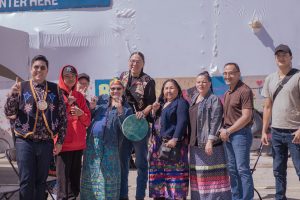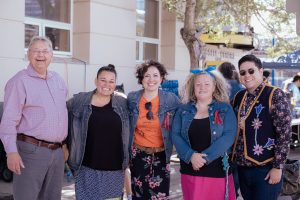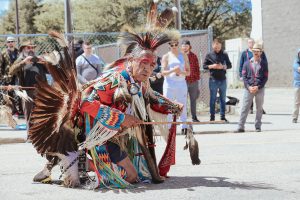The fire crackles in front of 14 Elders and Knowledge Keepers sitting in a circle sharing, reflecting, and trying to imagine a more positive future for their communities. They were all invited to Moonlight Bay Centre for a retreat to commemorate National Day for Truth and Reconciliation — a day that can be especially difficult for these Leaders in their communities.
Many of them have either witnessed firsthand the atrocities of residential schools or have close family members who have shared their own stories (if they came home at all). And while the Elders and Knowledge Keepers reflected on the past and the challenges of the present, a new feeling emerged, seemingly from the embers and ashes dancing off the campfire.
They felt hope for the future.

Thoughtful Reflections Sitting by the Water
While this retreat included much of what someone might expect to find at an all-inclusive resort, the true aim for this event was to pay homage to the hard work of Elders and Knowledge Keepers acting as near-constant beacons of hope, helping their communities to safer waters. And while grief and reflection were ever-present, so was friendship, comradery, love, and optimism that they will continue navigating troubled waters.
“Many of the Elders and Knowledge Keepers who attended told me they had no idea we had a property so close to the water like this,” says Janet Paskemin, Manager of Indigenous Cultural Supports. Moonlight Bay Centre sits on Wabamun Lake with wonderful views of the water and surrounding woods.
“Just being by the water can do a lot for Elders and Knowledge Keepers,” says Janet. “It can help them clear their minds, reflect more thoughtfully, and think much clearer. For a lot of this retreat, the Elders and Knowledge Keepers sat by the lake, sometimes talking but more often just in silence with each other.”

Comradery, Friendships, and the Gifts of Food
While some of the Elders and Knowledge Keepers who attended were longtime friends, just as many had never met — despite this, the comradery was more than evident. These bonds formed sitting by the lake, solidified by the fire, but it was in the kitchen where one of the strongest gestures took shape.
Food Sovereignty is an act where visitors to Indigenous Nations would receive food as a token of gratitude and friendship. True to honouring the customs and traditions from Indigenous Nations, one Elder, who was previously a Chef, insisted on making home-made pancakes for everyone at the retreat.
“In truth, he wanted to give something to his friends, the same way we were giving so much to everyone during that retreat,” says Janet. “It’s hard to understate how important gestures of honour, friendship, and love are for the Elders and Knowledge Keepers.”

Hope for the Next Generations
Janet recalls one thing she heard time and time again throughout the retreat: that the Elders and Knowledge Keepers see the work that’s being done for Indigenous Peoples by so many young people. She expressed how the Elders and Knowledge Keepers are so incredibly hopeful for the next generations to continue improving the lives of others.
We were honoured to host the 14 Elders and Knowledge Keepers at Moonlight Bay Centre to acknowledge National Day for Truth and Reconciliation. We’re proud knowing that these important leaders in their communities had an opportunity to not only rest and reflect but to connect, share, express, and revitalize.

June is an important month for Bissell Centre – it’s both Pride Month and National Indigenous History Month. There is a close connection between what Pride Month is all about and Indigenous history in our country.
Countless Indigenous Nations across what’s now called North America saw Two-Spirit Peoples as not only an engrained and normalized part of their culture — Two-Spirit Peoples were often highly regarded and seen as a gift from the Creator.
“They were a very important part of Cree society,” says Elder Ed Lavallee. He is a traditional Plains Nehiyaw (Cree) of the Sturgeon Lake First Nation in Saskatchewan whose career in advocacy for Two-Spirit Peoples has seen him collaborate with groups like Pride Edmonton, the Edmonton Queer History Project, and the Edmonton 2 Spirit Society. Quotes from Elder Ed Lavallee reflect the distinct experience of the Plains Nehiyah Peoples.
“They had many roles in the daily lives of their people and were respected and revered for being Two-Spirited. They were often healers, shamans, mediators in marriage and tribal disputes, keepers of their history and their lore, and taking part and often leading in their social and Spiritual Ceremonies.”
While colonial efforts tried to wipe out any non-conformity from a person’s ascribed gender, the presence of these folks never went away. It wasn’t until 1990 that this way of being was finally given a general English translation to help people across Canada understand that, for countless Indigenous Peoples today, there are far more than only two genders.

The Five Genders
For Indigenous Nations in what’s now called Alberta, there are five genders in the community: male, female, male with female spirit, female with male spirit, and transgender.
“Indigenous people believe that both the female and male spirits reside in the body of a Two-Spirit Individual and the degree of dominance of each spirit ultimately impacts the physical, emotional, mental and spiritual identity of each Two-Spirit person,” says Elder Ed Lavallee.
Rather than trying to change people to better fit with the gender they were born with, Indigenous Nations instead made room for these people and ensured they could contribute to the community with the tasks and skills they identified with most.
Males with female spirits could take on cooking and cleaning duties, were widely seen as gifted artists, and some Nations even saw them adopt orphaned children to take on a caregiver role. Females with male spirits contributed by hunting and being warriors. Some Nations saw females with male spirit folks marrying widowed women.
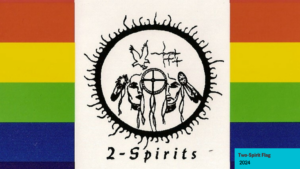
The Reverence for Two Spirit Peoples
In addition to the everyday contributions Two-Spirit Peoples made to their communities, their gift of having two spirits within them also meant they were good healers, medicine people, and visionaries. This is because the two spirits in them give them what’s called double-vision — the ability to see the world through both the male and female lens.
“The belief that Cree Two-Spirit People are special is epitomized in the existence of a powerful Two-Spirit Deity known as Qweskicanskew,” adds Elder Ed Lavallee. “In their spirituality, they believe this Spirit turns things around for the good and well-being of all things on earth. This important Spirit is called upon in prayers for help, protection and blessings.”
Two-Spirit Peoples were foundational to their communities. During colonization, Two-Spirit Peoples’ place in the world seemed to no longer exist. Through the mid- to late-twentieth century, as more Indigenous Peoples began to reclaim their identities, it was clear the different terms used in different Nations like Nádleehí (nad-lay-hee), Winkté (wink-tay), and Niso-acahk-iynew (nee-soh-achak-ee-noo) needed a translation for the wider public to understand.
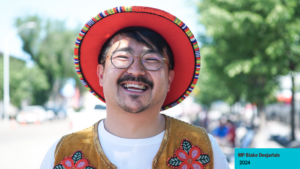
Bringing Two Spirit to the Wider Public
In 1990, at the Third Annual Intertribal Native American, First Nations, Gay and Lesbian American Conference, Elder Myra Laramee put forth the term Two-Spirit. The term is a translation from the Anishnaabemowin (Ojibwe language) term Niizh Manidoowag (neez man-ee-doo-wog). It was added to the front of the Pride acronym (2SLGBTQIA+) in recent years and was even a part of the focus for the Federal 2SLGBTQIA+ Action Plan launched in 2022.
Today, knowledge and understanding about Two-Spirit Peoples is spreading, but is still far behind from where it was before colonization. People like Dr. James Makokis (a Two-Spirit doctor from Kehewin Cree Nation) and MP Blake Desjarlais (a Member of Parliament from Edmonton) are sharing their stories to help more people understand why Two-Spirit Peoples are an essential part of their Nations – and to reduce the stigmatization around people living their authentic lives.
“They are emerging from their long decades of oppression and marginalization working toward re-establishing their rightful roles in their communities as they go through this period of rediscovery,” says Elder Ed Lavalle. “They are working to be recognized, respected and engaged in an integral manner, within Indigenous communities and society in general.”
This Pride Month and National Indigenous History Month, we’re celebrating the bravery of Two-Spirit people coming out and bringing this piece of Indigenous culture to the public forefront. We hope you’ll join us in making room for Peoples who can walk in both worlds to share their gifts and help make this world a more equitable place for everyone.
Bissell’s National Indigenous Peoples Day celebration weeks ago brought 96 St. right outside Bissell to life. Bissell Centre has been celebrating National Indigenous Peoples Day, proclaimed in 1996 by the Canadian Government, for well over a decade! This year, it was so much more than a block party– our team made sure this was a celebration to remember.

Keeping Traditions Alive
Our Food Services kitchen team made traditional stew and Bannock for everyone who attended. In total, they served more than 900 meals! Elders from the community held a traditional pipe ceremony to kick things off. They shared stories of struggle and expressed why the customs and traditions they grew up with are so important to folks from Indigenous communities.
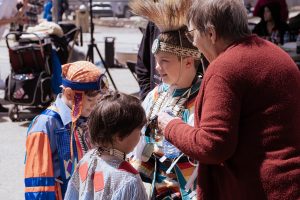
Energetic Local Performances
Families enjoyed the traditional hand games from Indigenous communities. Plus, dance and music performances from the Thunder Lake Singers & Dancers and flutist Theo Waskahat. The block was alive with music, drumming, and dancing for the whole community to enjoy.
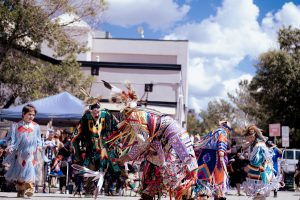
Sharing and Learning Together
National Indigenous Peoples Day is always an amazing celebration, but this year’s was truly one to remember. We’re so happy and grateful for everyone who came out, participated, shared their gifts, and helped make sure Indigenous customs and traditions will stay alive for the people who need them most.
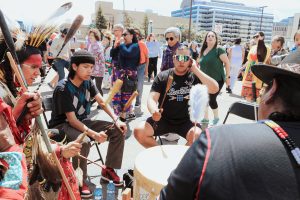
National Indigenous Peoples Day 2023 Photo Highlights
